
| What is Flavor and Fortune? |
| How do I subscribe? |
| How do I get past issues? |
| How do I advertise? |
| How do I contact the editor? |
Read 13030155 times
Connect me to:
| Home |
| Articles |
| Book reviews |
| Letters to the Editor |
| Newmans News and Notes |
| Recipes |
| Restaurant reviews |
| Article Index (all years, slow) |
| List of Article Years |
| Article Index (2025) |
| Article Index (last 2 years) |
| Things others say |
| Related Links |
| Log In... |
| Authors |
| Categories & Topics |
Chrysanthemum: Flowers and Leaves Bring Health and Happiness
| by Jacqueline M. Newman |
Food as Herbs, Health, and Medicine
Fall Volume: 2010 Issue: 17(3) page(s): 5, 6, and 7
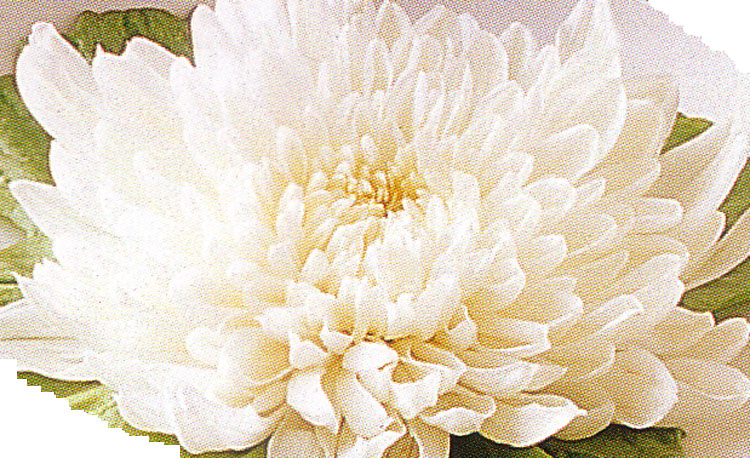
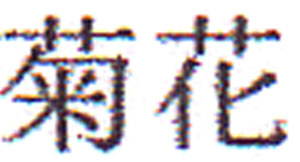 Look at a Chinese coin with this flower on one side and be reminded of this popular elegant food they consider valuable and delicious. It represents greatness, is called ju or ju hua, and it is sometimes called 'a flowering gentleman.' It is one of four flowering plants that symbolize nobility, the other three are bamboo, orchid, and plum. This one stands for getting or gathering together, and as such is praised for its greatness. Do you know it blooms after summer and that it is beloved and beautiful?
Look at a Chinese coin with this flower on one side and be reminded of this popular elegant food they consider valuable and delicious. It represents greatness, is called ju or ju hua, and it is sometimes called 'a flowering gentleman.' It is one of four flowering plants that symbolize nobility, the other three are bamboo, orchid, and plum. This one stands for getting or gathering together, and as such is praised for its greatness. Do you know it blooms after summer and that it is beloved and beautiful?
In the yin/yang dichotomy, this annual plant, be it flower or leaf, is considered warming. The wild plant has small yellow or white and yellow flowers. Known in ancient times, both flowers and leaves of the chrysanthemum were used for food and drink. People loved them, and as tea it was a most popular way to consume them.
The Chrysanthemum plants popular today were developed from earlier varieties; and they are still used in the same ways. In the 4th century, Ge Hong, a Taoist, used them to reduce fevers. He even made a fermented drink mixing them with one or more grains. In the 7th century, leaves of the flowers, when young, became popular as a food.
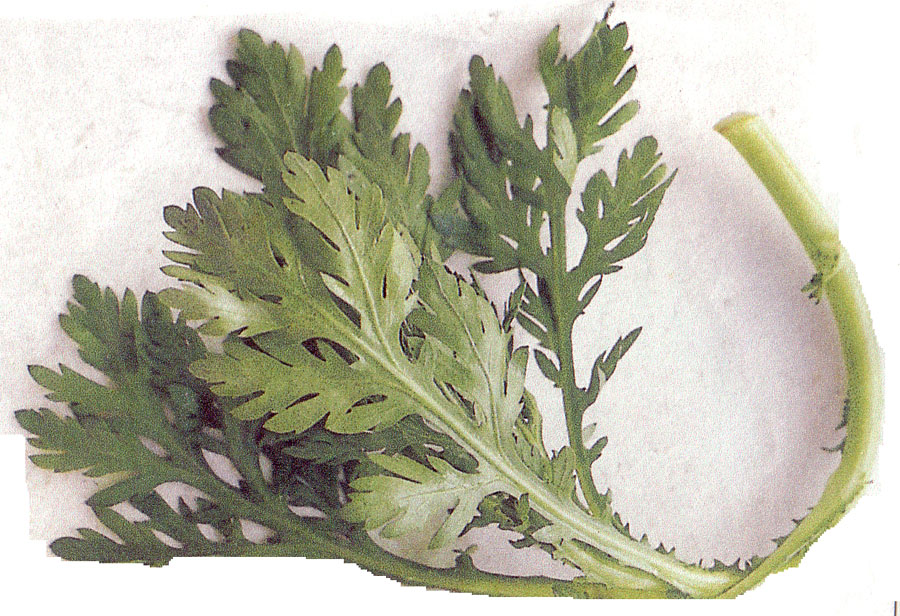
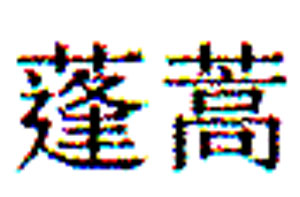 These ju or chrysanthemums, can be one of several related plants. People people stir-fry or steam all of their young greens which are commonly called tung hao. To a botanist, this is Chrysanthemum conurium, to an American, the greens are called 'garland chrysanthemum.'
These ju or chrysanthemums, can be one of several related plants. People people stir-fry or steam all of their young greens which are commonly called tung hao. To a botanist, this is Chrysanthemum conurium, to an American, the greens are called 'garland chrysanthemum.'
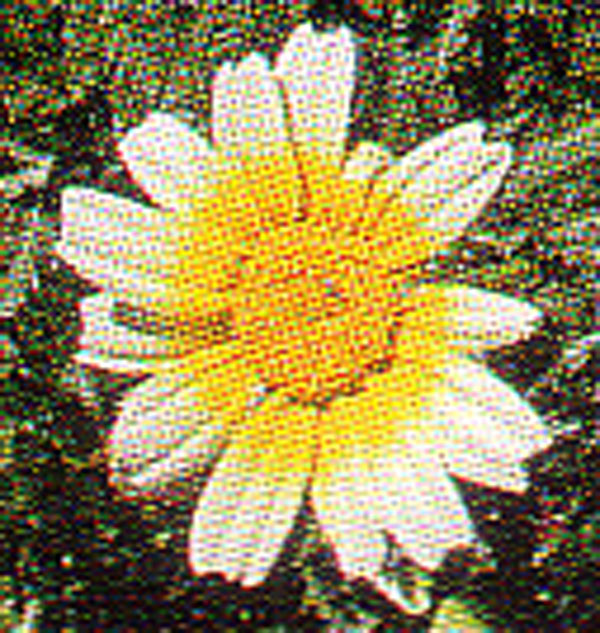 There is also a crown daisy known as Chrysanthemum spatiosum that is known by another name, hao cai, or the 'daisy potherb.' When young, these leaves and all chrysanthemum leaves are used, dropped into hot water or soup just before serving. To add to the confusion, some of the leaves used are Leucothemum conurium,the common flower Chrysanthemum indicum. Incidentally, the former has a slightly spicy flavor, the latter more sweet than spicy. No matter which flower, all symbolize life at ease and are said to be mostly male.
There is also a crown daisy known as Chrysanthemum spatiosum that is known by another name, hao cai, or the 'daisy potherb.' When young, these leaves and all chrysanthemum leaves are used, dropped into hot water or soup just before serving. To add to the confusion, some of the leaves used are Leucothemum conurium,the common flower Chrysanthemum indicum. Incidentally, the former has a slightly spicy flavor, the latter more sweet than spicy. No matter which flower, all symbolize life at ease and are said to be mostly male.
Males are looked up to and respected for their loyalty, and in China like to read and write poetry. As this flower is respected, many men like to raise them. Early men who did include Qu Yuan (339 - 278 BCE), Tao Yuanming (365 - 427 CE), and Huang Chao (birth unknown - 884 CE).
Qu Yuan is considered the father of Chinese poetry. He was a minister whose loyalty and his death are commemorated during the Dragon Boat Festival. Tao Yuanming became a recluse farmer after retiring at age forty-one and raising family and flowers. Quite poor after his early retirement, he nonetheless refused government jobs, even those offered by friends. Both he and Qu are known for their poetry, some about the chrysanthemum. Huang Chao led a near-the-end of the Tang Dynasty peasant revolution and was ultimately defeated. One of his poems became famous; it says: Let the chrysanthemum bloom with the peach, its aroma can fill the city of Chang-An. We now know that city as Xian.
These men and others touted the chrysanthemum and made breeding them popular. There were less than a handful of varieties in their day. By the Song Dynasty (960 - 1279 CE) there were some thirty-five different ones; there were three times that number during Yuan Dynasty times (1279 - 1368), nine hundred different varieties by the Ming Dynasty (1368 - 1644). In China today, men and women want their names associated with the chrysanthemum; many more are breeding them. There are more than three thousand different varieties today.
There are other interesting stories about this popular flower/food/herbal. One is about drinking tea when petals of this flower fell into a mountain stream in Hunan. Persons lucky enough to consume some lived for thirty years past their century mark; this story sends many folk to gardens and florists to locate them. Another chrysanthemum, the garland chrysanthemum, now has more than seven cultivars whose leaves can be small, round, broad, or so-called 'tiger ear.'
Not all chrysanthemum flowers are edible; nor are all of their leaves. Those with white or light yellow flowers almost always are, and they are often dried and used for tea, soups, or stews. Chinese like drinking their tea with fresh or dried flowers, and they love dining on their young leaves.
When I was a child, my aunt and uncle often took me to Chinatown for dim sum. With it then, they served chrysanthemum tea. We were always asked if we wanted it and I always did. Perhaps that was because I heard that this tea was good for eyesight and acne and thought people with pimples looked ugly. I drank a lot of it and all kinds of tea. I attribute my not having pimples and never needing glasses when young to this tea. What I did not know was that there was no real tea in chrysanthemum tea until I was an adult and began studying food science. Only then did I learn that it and regular tea did not keep pimples at bay; I was drinking lots of the wrong beverage.
I now know that the Chinese believe chrysanthemum tea is said to control dizziness, help the body eliminate toxins, reduce blood pressure and heart palpitations, relieve coughs, colds, and the flu, aid in relieving body sores, and help those with visual problems. I also learned later that importation of all chrysanthemum flowers was disallowed for a long time. The reason, spore and insect eggs that were difficult to kill. I do recall early on, when I could get it, I was drinking this tea with tiny black dots floating on its surface. Nowadays, this is no longer a problem, and I am pleased these dried flowers are available again on grocery and herbal store shelves. I still like this herbal tea and all teas.
Chrysanthemum flowers, their petals, and their young leaves do make their way into Chinese soups, stews, and beverages. Some recipes for them are touted to reduce fevers. Their boiled roots are said to cure headaches and restore bodily imbalances. This plant in almost all its forms in a very popular herbal.
In a cooking class years back, taught by the late Virginia Lee, I learned to bone a chicken, stuff it with a layer of minced shrimp and minced water chestnuts, then another layer of minced greens, and still another layer with minced chicken mixed with raw egg whites. Using a skewer I also learned to weave the chicken skin together before steaming. Before serving, in that class, we prepared a large handful of petals from white chrysanthemums and used them in a sauce for this beautiful delicious chicken. I still make it for guests, though not as often, perhaps because I spend lots of time trying new recipes and so entertain fewer guests than I did when younger.
Chrysanthemum and other flowers are great for decor, especially at weddings. One way to use them is to dip fresh or dried ones into stiffly beaten egg whites, and then let them dry. Some dip them into colored sugar before drying in a very low-temperature oven. They know chrysanthemum flowers represent happiness, joy, and fertility. Many do know never to use white ones at weddings because they represent death. One last thing about this plant in China, that is that Chrysanthemum morifolium, yet another variety, is used as a flower for herbal teas.
| Chrysanthemum Tea |
|---|
1 cup dried whole chrysanthemum flowers, stems removed and discarded 1 Tablespoon goji berries, minced 6 Tablespoon sugar Preparation: 1. Drop the whole flowers into boiling water for five seconds, remove and immediately put them in ice water, then drain them. 2. Boil three quarts of water and pour into a large non-reactive pot or container. 3. Add the goji berries and the sugar, stir, and allow to cool to lukewarm, then add the flowers (or only the petals, as desired. Strain and drink at that temperature or allow to cool to room temperature. |
| Chrysanthemum Stuffed Cabbage |
|---|
10 large pieces of cabbage 1 Tablespoon granulated sugar 2 Tablespoons vegetable oil, divided in half 3 Chinese black mushrooms, soaked, stems discarded, and minced 1 Tablespoon fresh ginger, peeled and minced 1 teaspoon Chinese brown sugar 1 tablespoon thin soy sauce 1 Tablespoon water chestnuts, minced 1 Tablespoon goji berries, coarsely chopped 1/2 cup minced chrysanthemum leaves 1 sheet dried bean curd, soaked for five minutes in warm water, then cut into ten pieces 1/2 teaspoon salt 1/4 teaspoon ground white pepper 1/2 cup chicken or vegetable stock Preparation: 1. Bring three cups of water to the boil, add the granulated sugar and one tablespoon of the oil, then the cabbage leaves, turn off the heat and allow to stand for eight minutes, then drain the leaves and set then aside. 2. Heat other tablespoon of the oil and stir-fry the mushrooms and the minced ginger for one minute, then add the brown sugar, soy sauce, water chestnuts, the goji berries, and the minced chrysanthemum leaves and stir-fry for two minutes, then set aside to cool somewhat. 3. Lay one cabbage on a board or plate, and cut away the thick center part of the leaf. Put one piece of the bean curd on it in the center, and two scant tablespoons of the mushroom mixture in the center of this. Roll partway, fold in the sides and roll completely and put edge side down on a heat-proof deep plate. 4. Pour the stock over the cabbage rolls and steam over boiling water for five minutes, then serve. |
| Chrysanthemum Greens |
|---|
2 pounds chrysanthemum greens, washed and drained 1 square brown bean curd, (2 x 2 inches by ½ inch) 1 Tablespoon sugar 1 Tablespoon Chinese rice wine 3 Tablespoons sesame oil Preparation: 1. Cut the greens into two-inch long pieces, and blanch them in boiling water for one minute then immediately into ice water, drain, squeeze out any remaining water, and then toss with chopsticks to separate the pieces. 2. Mix slivers of bean curd with the chrysanthemum leaves, toss and then add the sugar, rice wine, and sesame oil and toss again, then serve. |
| Pork and Chrysanthemum Clay Pot |
|---|
1 onion, thinly sliced 3 cloves garlic, minced 1 one-inch knob of fresh ginger, peeled and minced 1 Tablespoon vegetable oil 1 pound pork chop bones simmered in one cup of water to make a stock 3 pork chops, the meat shredded, the bones simmered for half hour in one cup of water to make a stock, strain, then discard the bones 4 leaves of celery cabbage, cut into half-inch pieces 3 Tablespoons wood ear fungi, soaked, any hard parts discarded, and torn into half-inch pieces 20 to 30 dried day lily buds, soaked until soft 1 four to six ounce can bamboo shoots, thinly sliced 6 cups vegetable oil 1 crust of dried cooked regular or glutinous rice crusts, broken into one-inch pieces (about one cups worth 1 Tablespoon dark soy sauce 2 Tablespoons thin soy sauce 2 teaspoons sesame oil 2 large white chrysanthemums, petals removed, everything else discarded Preparation: 1. Heat a wok or fry pan, add the tablespoon of oil, and stir-fry the onion, garlic, and ginger for one minute. Then add the pork and stir-fry until it is no longer pink. 2. Add celery cabbage, drained day lily buds, fungi pieces, and bamboo shoots and stir-fry for one minute, then add the reserved stocks. Remove and set aside. 3. Wash and dry the wok, add the six cups of oil, and deep-fry the rice crusts until light tan. Remove them to a crock and set the oil aside for another use. 4. Reheat the onion mixture to the boil, add both soy sauces and the sesame oil, and simmer for half an hour, then remove the contents to another crock pour filled with the fried rice crusts. Sprinkle with the chrysanthemum petals and serve. Do not stir them in, just serve the mixture with them on top, some will get tossed in as this dish is consumed. |
| Rolled Stuffed Dry Bean Curd |
|---|
5 sheets dry bean curd (each 20 by 10 inches) 1/2 cup dark soy sauce 1/2 slab Chinese brown sugar 1/2 cup vegetable oil 1 cup chrysanthemum petals about one yard of string Preparation: 1. Soak bean curd sheets in warm water for twenty minutes, then drain and set aside in a large deep bowl. 2. Bring soy sauce, sugar, and vegetable oil to the boil, and pour over the bean curd sheets, and let rest for half an hour or until they can be handled. 3. Remove the bean curd sheets from the bowl and sprinkle chrysanthemum petals evenly over each one, then roll them up one by one, but not too tightly. Tie them at the ends and once or twice in the middle, then return the rolls to the bowl, edge down, into the soy sauce mixture and steam over boiling water for one hour. 4. Remove the rolls, discard the liquid in the bowl, cut the strings and discard, and thinly slice the rolls and serve hot, warm, or cold. |
| Chicken with Chrysanthemum Petal Sauce |
|---|
1 large chicken breast, skin and bones removed,, sliced thinly 1 egg white, beaten until frothy but not firm 1/2 teaspoon salt 1/8 teaspoon ground white pepper 1 teaspoon Chinese rice wine 2 teaspoons water chestnut flour 1 large white chrysanthemum, petals removed, rinsed, and set aside, stem and sepals discarded 3 cups vegetable oil 1 scallion, coarsely minced 2 slices fresh ginger, coarsely minced 1/2 cup chicken stock mixed with one teaspoon of cornstarch Preparation: 1. Mix chicken slices with egg white, salt and pepper, rice wine and water chestnut flour and allow to rest for half an hour. 2. Heat oil in a deep sauce pan and deep fry the chicken for one minute, then drain and set aside on paper towels, reserving one tablespoon of the oil. 3. Heat wok or fry pan, add reserved oil, and stir-fry the scallion and ginger pieces for half minute, then add the fried chicken, stir for half minute then add the chicken stock mixture and bring to the boil stirring until it thickens. 4. Add the chrysanthemum petals on top, and stir just before serving. |
| Three Cup Chrysanthemum Beverage |
|---|
2 teaspoons goji berries 2 teaspoons chrysanthemum petals 2 mulberry leaves, minced 1 half-inch piece of cinnamon bark Preparation: 1. Smash the goji berries with the side of a cleaver. 2. Coarsely chop the chrysanthemum petals. 3. Bring three cups of water to the boil, then add the four ingredients, turn off the heat, and let stand for one hour before straining and drinking the liquid. |

Copyright © 1994-2025 by ISACC, all rights reserved
Address
3 Jefferson Ferry Drive
S. Setauket NY 11720